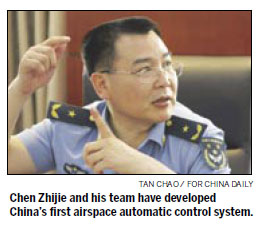Life and Leisure
Reaching for the sky
By Xin Dingding (China Daily)
Updated: 2010-08-25 14:10
 |
Large Medium Small |
It was the mid-1990s. A young Chinese scientist stood rooted to the spot in Denver airport, overwhelmed by the swarm of air travelers around him. The numbers, he reckoned, were easily the same as for the whole of China.
Chen Zhijie was on his maiden visit to the United States, having been chosen by the air force to develop China's first airspace automatic control system.
Shocked by the yawning gap in the numbers accessing air travel between the US and China, Chen vowed to plug it.
More than a decade later, Chen's dream has come true, and earned him the honor of being named a major general.
Asked why it took him and his team 13 years to complete the project, he says: "In the beginning, we had no idea about how to start the job."
There were no precedents to follow.
"Everything had to be built from scratch," he explains.
In the early 1990s, China's civil aviation industry had just begun to take off. Flying was no longer a privilege reserved for top-ranking officials. It was open to anyone who could afford an air ticket, without having to submit documents to prove his or her pedigree.
The fast-growing sector demanded more airspace to sustain its development, but this was in the hands of the air force, which was then still dependent on telephone and radio to manage the airspace.
A more efficient control system was an urgent necessity and the task fell upon the young shoulders of Chen, then 30.
With this came the opportunity to study nearly two months at the Massachusetts Institute of Technology.
It was on this trip that he saw a single airport handling flights equivalent to that for all of China; US scientists were also developing technologies that were only a concept in China.
"The huge gap was a big boost," he says.

When he returned, he did not bring back chocolates or candies for his colleagues, but rather two whole bags of study materials.
Slowly, his team was able to conceptualize what they wanted to build. Chen recalls visiting 49 civil airports to survey passenger traffic volume. He used every available means of transportation, including ox cart, to reach remote military airports.
All this hard work bore fruit with the system being put into operation in 2000. In 2006, their efforts were honored with the country's top scientific awards.
Thanks to the automatic control system, Chinese airports can now handle one flight every minute; the longitudinal interval between planes has been shortened to 20 km from 150 km; and the vertical interval to 300 m from 1,200 m. These changes mean more commercial flights at the same time, creating a favorable environment for the double-digit growth of China's civil aviation sector.
China Daily